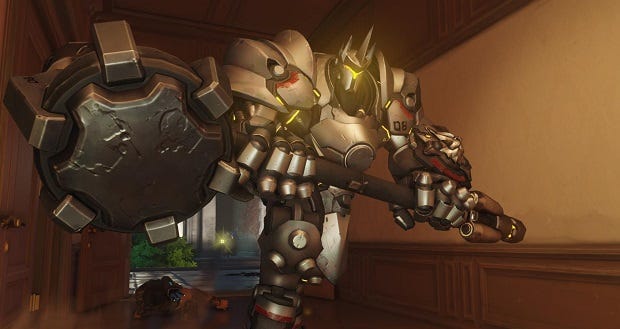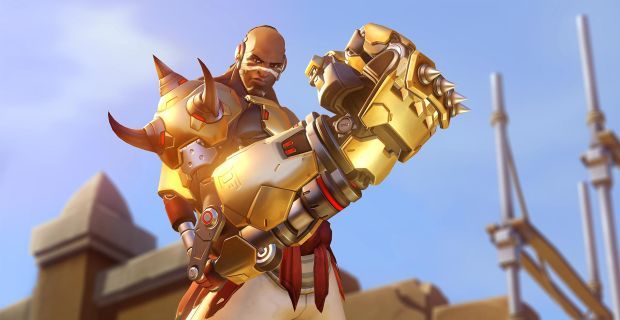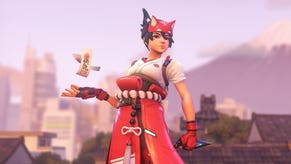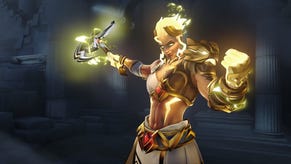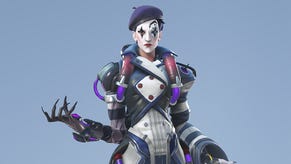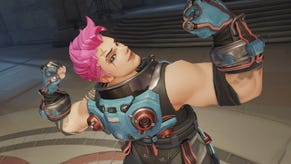A reminder that Overwatch should be the friendliest shooter ever
Mercynaries
At its best, Blizzard's Overwatch is the place I hope to wake up in when I die, die, die. A superspy sitcom that just happens to be a sublime entwining of FPS and MOBA, it has gulped down more of my free time than any other game in the past five years. It's also the game where I never speak to anybody, rarely accept a party invite and seldom spend longer than half an hour in ranked play. Some matches, I even try to avoid eye contact. Overwatch's community has become notorious for abusive behaviour, and while I'm not convinced it's any worse on this count than, say, Destiny or Call of Duty, the toxicity is completely at odds with the design, which makes it all the more jarring.
Overwatch isn't just a brilliant shooter debut from a studio hitherto celebrated for Orc huts, Zerg rushes and 24-hour raids; it's a flawed act of redefinition, a stab at changing the ethos of a genre famously inclined to wallow in its own malevolence, especially now that serving the often-toxic world of eSports has become a publisher priority. It does this not by trying to start afresh, but on the contrary, by diving back into the history - melting down venerable FPS playstyles, archetypes, guns, quirks and themes, and moulding them into something more hopeful and inspiring, with reference to Blizzard's vast back catalogue of MOBA heroes and RTS units. It is designed, however naively or cynically, to be sunny and welcoming where shooters like Black Ops 3 are awash with macho despair.
There are the obvious checks to anti-social behaviour, like the way the medal system downplays the almighty K:D (kills:deaths ratio) in favour of team-oriented feats like spending lots of time near the payload, or restoring an eye-catching proportion of your team's lost health. There are the spawn rooms, match-bridging safe spaces where a multitude of loose props, Easter eggs and defaceable surfaces foster a spirit of whimsy, at least when people aren't cussing out the Hanzo player or teabagging the defending side through the door.
These chambers have a practical role within the map architecture – forcing your way out of them or keeping the other team bottled up within is a vital phase in every escort match - but they're most valuable as opportunities to unwind with and take the measure of comrades. Some of my fondest memories in Overwatch consist of standing in a ring with my team, exchanging emotes and one-liners while the enemy Genji peers in like a hungry Black Friday shopper.
Heroes are where Overwatch's reworking of the FPS really comes into focus. Each is a cunningly transmuted mixture of influences from pop and gaming culture, sending familiar concepts in unfamiliar directions. The cast aren't just appealing reworkings of cliches like the femme fatale sniper or the crusty German knight – they're statements about shooter playstyles that extend worldwide and date back to the 90s. Junkrat's ability to use his own landmines as launchers, transforming a ghastly camper into a really nasty skirmisher, channels Quake's rocket-jumping. Soldier 76, famously, is the hard-bitten Modern Warfare dudebro equipped to dish out mid-range automatic fire and explosives, his Ultimate ability a parody of the “aim-bot” hacks that first appeared in Counter Strike. Having Soldier around lets Blizzard ease in players accustomed to dreary military shooters, even as his lack of a distinct strength subtly makes a case for diversity in more ways than one.
Other characterisations take aim at how competitive gaming has flourished and, perhaps, soured as online has become ubiquitous. Consider how Blizzard has baked “prosumer” toxicity into the game in the shape of Doritos-chugging Starcraft celeb D.va, a hero who plays to win, never loses gracefully and was originally designed to operate as a hyperactive battering ram. D.va is a study in abrasiveness - her legendary Ultimate activation phrase even pokes fun at player resentment when developers tweak their favourite classes - but she's also a teenage girl who has fought her way to the top of a male-dominated scene. She encompasses the rancour of ranked play, but she's also something to aspire to.
Ditto Ana, a re-imagining of the aloof elite sniper as protective grandmother, and Tracer, one of the biggest lone wolf jerks you'll ever run into and one of the few queer characters to appear on a game's boxart (a fact that was, admittedly, revealed or retconned into the lore only months after release).
If these personas are inspiring and provocative in themselves, they're even more intriguing when their ability sets lock together. Overwatch's teamplay design often feels less like an abstract question of stats, more the act of elaborating upon backstory chemistry. The sense is of strong personalities in synch rather than just movesets that compliment one another. Among the classic pairings is rocket trooper Pharah and angelic burst healer Mercy. By herself, Pharah is essentially a very angry piñata, easily picked off by a hero like McCree unless she catches the other team out from the side or rear. With Mercy gliding behind her, overclocking her launcher and patching her up, she's a regular end-of-level boss.
The thrill of tanking potshots aside, having Mercy around is entertaining for Pharah players because it gives you a tacit bonus objective – keep the healer safe, by staying aloft during crowded encounters and manoeuvring near pillars and roof edges. For Mercy players, meanwhile, riding Pharah's coat tails is fun not just because you'll usually live longer, but because you can enjoy the spectacle of combat from above. I've yet to play a shooter that encourages such a rapport so beautifully - small wonder that “Pharmercy” is one of the fanshipping community's favourite match-ups.
Similarly, the brilliance of buff Russian tank Zarya's ability to cast shields on players, adding any incoming damage to her power reservoir, is that it establishes a one-to-one intimacy. For those brief energy bubbles to be effective - both in terms of your ability to dish out punishment, and helping your comrades survive - you must keep a close eye on allies and anticipate exactly when they'll be in hot water. When you're playing Genji with his Deflect skill on cooldown, and Zarya pops a shield on you just as you're hooked by Roadhog, the relief is heightened by the awareness that somebody has been watching over you throughout, ready to step in. It isn't just “good team comp”. It's Big Sister coming to the rescue.
As with the heroes, the maps are a change of tune for a genre that is a little too enamoured of muck and misery. Overwatch's premise of a team of vigilantes roaming the Earth in search of things to shoot is, of course, deeply suspect: you could argue that it is a more insidious celebration of interventionalism than the likes of Battlefield, because its universe is so utterly charming. But it does, at least, portray the nations of the “developing” world as more than a pile of bombed-out buildings. Most video game recreations of Iraq are wastelands derived from Gulf War UAV footage, hopeless warzones fit only to serve as CryEngine tech demos or places where all-powerful Westerners learn Hard Lessons about ethics.
Overwatch's Oasis map, by contrast, is a futuristic garden paradise dotted with beehive structures and robot butlers. Its African level, the savanna-side metropolis of Numbani, is a gleaming field of skyscrapers and holograms. There is much to criticise about these interpretations, which - like the game’s preposterous unlockable outfits - lean on racial caricature and the mercenary blending of “ethnic” motifs, but their utopian appearance at least goes against the grain.
So why, given the breadth and elegance of Blizzard's attempts to reinvent its genre, does Overwatch's community have such a reputation for strife and bigotry? One explanation is that, in opting for a more inclusive cast that, moreover, straddles a whole cluster of design trends and priorities, the game has made itself a platform for the games industry's on-going, multi-faceted culture war. Characters like Tracer or Symmetra, an autistic Indian woman armed with a homing beamcannon, have become touchstones in clashes over representation and the competing claims of pros and “casuals”.
The pro/casual divide has really come to the fore in recent months, thanks to controversial changes to Mercy, Overwatch's premiere healer. Her new Ultimate trades the ability to resurrect any team member within a small radius for an overall boost to her attacks, agility and abilities: she can still resurrect players, but only individually. This has done away with one of the more controversial Mercy behaviours – sacrificing your team on the altar once your Ultimate is charged so you can swoop in and revive them for a potential Play of the Game, much to the aggravation of both sides.
In the process, Mercy has also become more of an offensive character who needs to stay close to the team's damage-dealers and tanks to be effective. The overall significance of this is to heighten a tension between hardcore players, who tended not to pick Mercy, and less able or skilled participants for whom big team resurrections were a relatively easy way of contributing to a win. Suddenly, Mercy is one of the heroes people pick first, and any player who can’t stay alive in the thick of it is badgered to change character.
You could make the case that Overwatch is, above all, an expression of growing pains. Where older shooters have begun to sink into themselves, rediscovering the past as they strain for relevance in the present, this is a game that embraces a transition from a creative community dedicated to prosumer power fantasies to a community that is more, well, communal. You could compare the game to “solarpunk”, that younger cousin of cyberpunk which doesn't just linger on the decay of networked capitalism but envisages a world after it, a world of green cities, sustainable diets and, as far as I can tell, everlasting arts-and-craft fairs.
Similarly, Blizzard's game aspires on some level to be a post-shooter shooter. Its intro movie, in which enlightened ape Winston bellows “someone has to do something!” amid scenes of death and destruction, rings pretty hollow as a narrative justification for the ensuing slaughter, but can be read as a call to action the rest of the designwork struggles to answer.
